Spectroscopy & Non-Proton MR
Digital Poster
Spectroscopy & Non-Proton MR
4201 -4225 Non-Proton MRS/MRI
4226 -4250 MRS Acquisition & Analysis
4251 -4254 (B) MRS: Acquisition & Analysis 2
Non-Proton MRS/MRI
Digital Poster
Digital Poster
Spectroscopy & Non-Proton MR
Wednesday, 15 May 2019
| Exhibition Hall | 16:45 - 17:45 |
| Computer # | |||
4201. 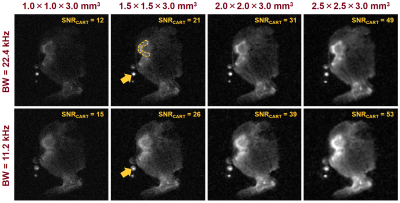 |
1 | Sodium MR Imaging of Porcine Articular Cartilage on a Whole-body 10.5T MR System – Initial Results
Stefan Zbyn, Gregory Metzger, Russell Lagore, Naoharu Kobayashi, Casey Johnson, Kai Ludwig, Ferenc Toth, Cathy Carlson, Gregor Adriany, Jutta Ellermann
New advancements in ultrahigh-field human whole body 10.5T MR imaging hold potential for improvements in sodium imaging of articular cartilage. We investigated optimal imaging parameters and image quality for the evaluation of sodium concentrations in porcine articular cartilage using a 3D-UTE sequence and birdcage sodium knee coil at 10.5T. The mean sodium concentrations in femoral and patellar cartilage of a porcine stifle joint were 298 and 307 mM/L, respectively. These values are in good agreement with previously-published concentrations. Our findings support the feasibility of sodium imaging of articular cartilage at 10.5T and motivate future in vivostudies.
|
|
4202. 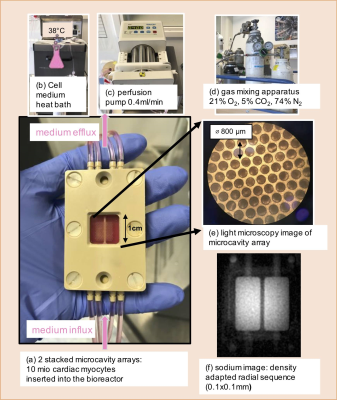 |
2 | Non-invasive assessment of myocardial cell viability based on 23Na triple-quantum signal
Michaela Hoesl, Till Wüstemann, Matthias Malzacher, Cordula Nies, Eric Gottwald, Lothar Schad
Sodium MRI was proposed in addition to cardiovascular magnetic resonance methods to detect viable cells. In this work, a spectroscopic sequence with time proportional phase increments was used to measure single- and triple quantum coherences of the spin 3/2 sodium nuclei simultaneously. We investigated the sodium triple-quantum signal of cardiomyocytes in an MR compatible bioreactor to gain further understanding of the TQ signal of cardiomyocytes under stimulation. This setup may be applied in the future to simulate additional diseases as well as potentially monitor the single-quantum and triple-quantum signal changes, e.g. in hypertrophy and after myocardial infarction in-vivo.
|
|
4203. 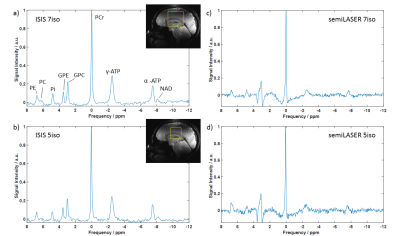 |
3 | 31P Single Voxel MRS in the Human Brain at 9.4T: ISIS versus SemiLASER
Johanna Dorst, Loreen Ruhm, Nikolai Avdievich, Wolfgang Bogner, Anke Henning
In vivo phosphorus MR spectroscopy has been established to be a powerful tool for studies of energy metabolism. To provide clinically relevant information about physiologic function, accurate spatial localization as well as sufficient spectral quality are fundamental requirements. Therefore, in this study, first steps to optimize a multi-shot ISIS sequence and a single-shot semiLASER sequence for phosphorus MR spectroscopy in the human brain at 9.4T have been taken. The sequences were compared in terms of localization accuracy and SNR.
|
|
4204. 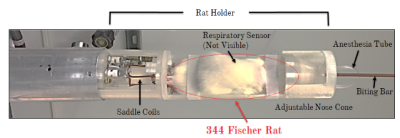 |
4 | Ultrahigh Field (14.1 Tesla) 1H/23Na MRI of the Rat Tail In Vivo: A Comparison Study
L. Tyler Williams, Lukas Neuberger, Daniel Cortes, Thomas Neuberger
This study verified the ability to acquire high resolution sodium and proton MR images of rat tail intervertebral discs in vivo. Utilizing the hardware developed in a previous study, female Fischer 344 rats were imaged in vivo. Resolutions of 78um isotropic and 500um isotropic were achieved for proton and sodium images respectively prior to zerofilling. Comparisons between in vivo and ex vivo images showed similar anatomical and biochemical results. However, slight differences in the sodium images were observed. Sodium concentration was estimated using blood in the ventral tail artery as a reference.
|
|
4205. 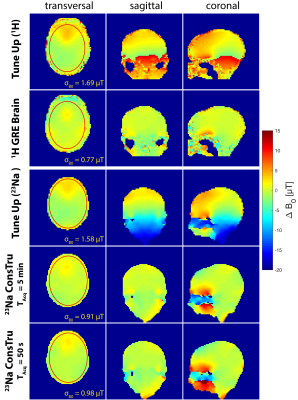 |
5 | B0 shimming for X-nuclei imaging at 7 T using 23Na B0 maps
Lena V. Gast, Anke Henning, Bernhard Hensel, Michael Uder, Armin M. Nagel
B0 inhomogeneities are a major challenge at ultra-high magnetic field strengths (B0 ≥ 7 T), as they can lead to strong image artifacts. In this work, a B0 shimming routine that is based on 23Na B0 maps was implemented for applications in X-nuclei imaging where no 1H MRI data can be acquired and therefore, no vendor-provided shimming routines can be used. The proposed 23Na ConsTru shimming routine showed an improvement in B0 homogeneity comparable to the vendor-provided GRE Brain shimming routine both in phantom and in vivo measurements using 23Na B0 map acquisition times less than 1 minute.
|
|
4206. 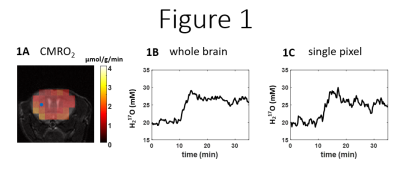 |
6 | Oxygen-17 MRI Reveals Unchanged Cerebral Metabolic Rate in Aquaporin-4 Knockout Mice
Yifan Zhang, Yuchi Liu, Kui Xu, Ciro Ramos-Estebanez, George Farr, Joseph LaManna, Walter Boron, Xin Yu
This study aimed at investigating the role of aquaporin-4 (AQP-4)-facilitated gas transport in regulating cerebral metabolism. Cerebral metabolic rate of oxygen (CMRO2) was quantified in AQP-4 knockout and wildtype control mice using oxygen-17 (17O) MRI. Our results showed no change in CMRO2 in AQP-4 knockout mice, suggesting that AQP4-facilitated gas transport is not a rate-limiting factor in cerebral metabolism in anesthetized mice.
|
|
4207. 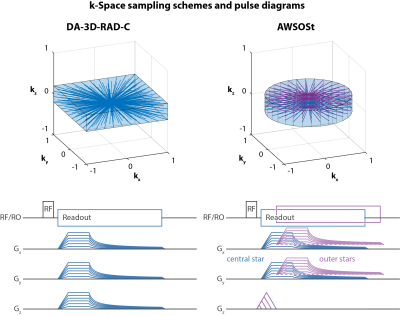 |
7 | Comparison of anisotropic UTE sequences for 23Na/39K imaging in the human calf at 7T
Max Müller, Lena Gast, Bernhard Hensel, Michael Uder, Armin Nagel
Anisotropically scalable UTE sequences enable a higher in-plane resolution for X-nuclei imaging. In this work, a density-adapted 3D radial cuboid acquisition scheme is compared theoretically and experimentally against a 3D acquisition-weighted density-adapted stack-of-stars (AWSOSt) design. For the use case of 23Na/39K imaging in the human calf at 7T, it was found that, when driven at similar and clinically feasible measurement times, the AWSOSt approach provides an increased SNR at the same effective resolution. Potential T2 blurring due to the additional phase encoding had no significant effect in this study. For both sequences a good suitability for anisotropic X-nuclei MR imaging in muscular tissue was confirmed.
|
|
4208. 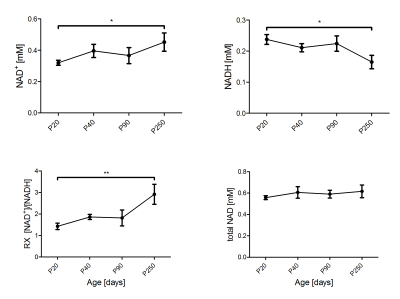 |
8 | In vivo study of cerebral NAD contents and Redox State during mouse brain development.
Radek Skupienski, Kim Do, Roger Marti, Lijing Xin
Nicotinamide adenine dinucleotide (NAD+ and NADH) is a key player of cell energy metabolism. 31P-MRS has been demonstrated for in vivo measurement of NAD content and redox state in cat and human brain. We previously demonstrated the feasibility of NAD measurement in mouse brain, and actually we established the in vivo profile of cerebral NAD+, NADH and NAD+/NADH at different ages. This study demonstrated also the feasibility of in vivo measurement of NAD+, NADH and redox state from 20 to 250 days old animals and it opens widely the prospect of studying longitudinally the energy metabolism and redox dysfunction in mouse models of brain pathologies.
|
|
4209. 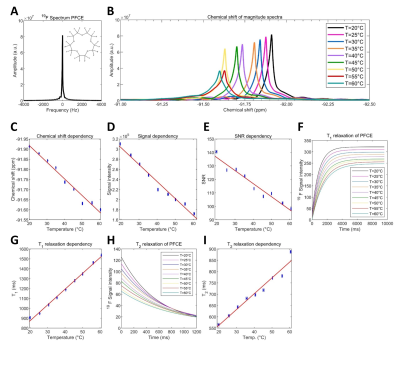 |
9 | Fluorine-19 Magnetic Resonance Thermometry: Temperature Dependence of Spin-Lattice and Spin-Spin-Relaxation Times of Fluorinated Drugs at 9.4 T
Christian Prinz, Paula Ramos Delgado, Thomas Eigentler, Ludger Starke, Thoralf Niendorf, Sonia Waiczies
Fluorine-19 (19F) magnetic resonance is a powerful tool for tracking fluorine labelled markers, cells and drugs. Here, we studied the influence of temperature on the 19F MR characteristics (chemical shift, T1, T2, SNR) of four fluorinated drugs using 19F MR mapping and spectroscopy techniques. We demonstrated the impact of temperature on the T1 relaxation time of PFCE nanoparticles in vivo and postmortem. Our findings open a trajectory toward 19F MR-based thermometry and indicate the need for adapting MR sequence parameters according to temperature induced environmental changes. This will be an essential requirement for monitoring fluorinated compounds by 19F MR techniques in vivo.
|
|
4210 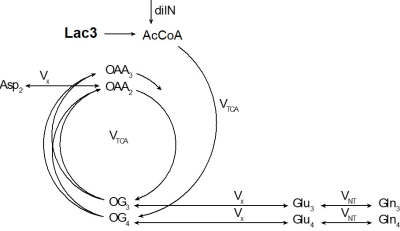 |
10 | Neuronal energy metabolism in the mouse brain measured by 1H-[13C] MRS at 14.1T under [3-13C]-Lactate infusion: a feasibility study Video Permission Withheld
Bernard Lanz, Lijing Xin, Nicolas Kunz, Hongxia Lei
In this study, the feasibility of studying neuronal energy metabolism in the mouse brain in vivo under [3-13C]-Lactate infusion, measured by 1H-[13C] MRS at high magnetic field was evaluated. Brain tissue [3-13C]-Lactate enrichment and the turnover of its metabolic products were measured dynamically. Glutamate and glutamine C4 as well as glutamate+glutamine C3 were used as input to a one-compartment metabolic model of the neuronal TCA cycle and glutamate-glutamine cycle, enabling a comparison with previously reported values of metabolic fluxes in the mouse brain under infusion of other labeled substrates.
|
|
4211. 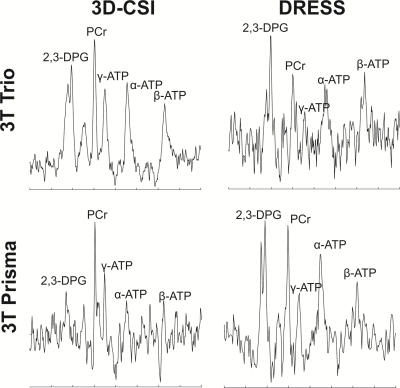 |
11 | Comparison of human cardiac 31P-MRS on 3 T Trio and Prisma scanners
Jane Ellis, Moritz Hundertmark, Marco Spartera, William Watson, Christopher Rodgers, Ladislav Valkovic
Cardiac PCr/ATP ratios measured by 31P MRS are a measure of the biochemical “energy reserve” in the heart. They decrease early in the progression of a wide range of diseases, making them a valuable biomarker. Logistically, it is often important for a long-running study to be able to compare data acquired on different MRI scanners. In this study, we show that comparable results may be acquired with 3T Prisma and 3T Trio scanners by scanning 10 healthy volunteers with 31P-CSI and 31P-DRESS on both systems. It is legitimate to pool 3T Prisma and 3T Trio data for clinical studies.
|
|
4212. 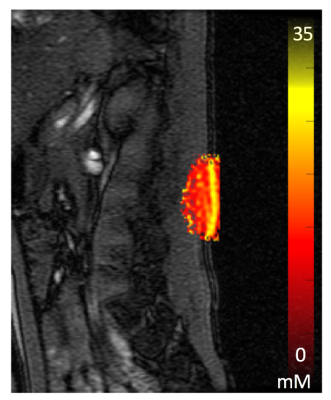 |
12 | Preliminary investigation into the effect of diuretic treatment on in vivo skin sodium using ultra-short echo time 23Na MRI at 3T with biopsy validation
Frank Riemer, Joshua Kaggie, Mary McLean, Viknesh Selvarajah, Kathleen Connolly, Ilse Patterson, Bruno do Carmo, Rolf Schulte, Ian Wilkinson, Martin Graves, Ferdia Gallagher
In this ongoing study, we investigate the changes in skin sodium concentration between controls and a group receiving a diuretic for seven days and present results from an interim analysis. Ultra-short echo time 23Na-MRI is performed at baseline and after seven days, at the end treatment. Results are correlated with measurements of sodium from biopsy samples.
|
|
4213. 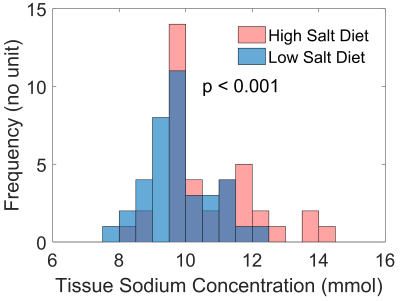 |
13 | Sodium MRI allows detecting an enhanced sodium concentration in muscles of volunteers following a high salt diet
Bastien Milani, Nicolas Loncle, Wendy Brito, Michel Burnier, Menno Pruijm
The presented study shows by the mean of sodium MRI that the sodium content of the leg muscles of healthy volunteers is higher when following a high salt diet than when following a low salt diet. To our knowledge, this is the first study reporting that fact.
|
|
4214. 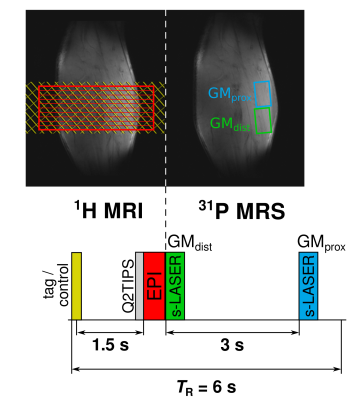 |
14 | Longitudinal heterogeneity of post-exercise perfusion, T2*-weighted MRI and high-energy phosphate metabolism in human calf muscle quantified by interleaved multislice 1H MRI and multivoxel 31P MRS at 7T
Fabian Niess, Albrecht Schmid, Wolfgang Bogner, Michael Wolzt, Pierre Carlier, Ewald Moser, Martin Meyerspeer
Multivoxel 31P semi-LASER was used to acquire time-resolved spectra from two positions along the gastrocnemius medialis muscle during rest, exercise and recovery. Simultaneously, quantitative perfusion- and T2*-weighted images of the calf were acquired with multislice 1H ASL MRI, in an interleaved fashion. Significantly different results were found with 31P MRS along gastrocnemius medialis: proximally, end-exercise PCr depletion was higher, PCr recovery times longer, end-exercise pH was lower and maximum oxidative capacity was also lower. Significantly higher post-exercise perfusion and slightly stronger T2*-weighted signal increase were found in proximal slices, which is consistent with the aforementioned distribution of metabolic activity.
|
|
4215. 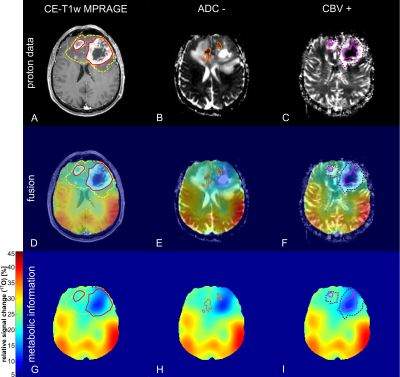 |
15 | Metabolic Brain Tumor Analysis: Correlation between ADC/ CBV and quantitative CMRO2 employing dynamic 17O MRI
Sebastian Niesporek, Nina Weinfurtner, Armin Nagel, Mark Ladd, Heinz-Peter Schlemmer, Daniel Paech
Dynamic 17O-MRI enables a direct measurement of the cerebral metabolic rate of oxygen (CMRO2). Decreased CMRO2 in tumor tissue indicates a change in the metabolic pathway and therefore metabolic imaging can be used as a diagnostic parameter. Data of three high grade tumor patients where investigated with regard to cerebral blood volume (CBV) hyper-intense and apparent diffusion coefficient (ADC) hypo-intense areas to exclude bias of perfusion and ADC. No significant change in CBV+ and ADC- volumes demonstrates the independence of tissue perfusion and cellular density of utilized method and underline the capability of fully quantitative metabolic imaging.
|
|
4216. 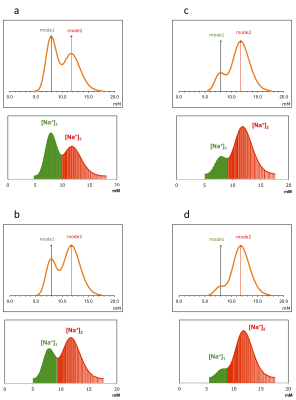 |
16 | Multiparametric statistical quantification of the heterogeneity of free Na+ concentration by 19F NMR spectroscopy
Norbert Lutz, Monique Bernard
Sodium(I) (Na+) plays a key role in basic cell function. Noninvasive methods for measuring intracellular Na+ concentrations ([Na+]i) in biological tissue have been developed on the basis of 19F NMR spectroscopy. By contrast, 23Na MRI at most provides approximate (relative) contributions of intracellular Na+ to total 23Na by relying on a number of theoretical assumptions, as it does not detect Na+i selectively. Since [Na+]i values are often not uniform throughout a given tissue volume (or voxel), we have designed an approach for quantifying total [Na+]i heterogeneity by exploiting the lineshape of the 19F resonance of an appropriate [Na+]i reporter molecule.
|
|
4217 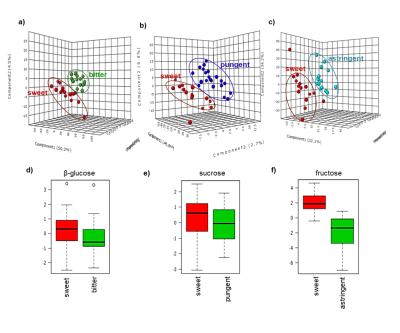 |
17 | Novel chemosensory application of 1H and 13C NMR metabolomics in medicinal plants of nutritional value Video Permission Withheld
Aruna Singh, Rama Jayasundar, Dushyant Kumar
With increasing incidences of diet and nutrition related diseases, objective evaluation of the chemosensory property of taste has gained significance. In this study, aqueous extracts of select medicinal plants of nutritional value (n=72) from five chemosensory groups were studied using proton and carbon NMR spectroscopy. Partial Least Square Discriminant Analysis of 1H and 13C spectral data have shown chemosensory based differentiation. Examples of targeted metabolomics aided identification of chemosensory markers are: β-glucose (sweet), phenylalanine (bitter), gallic acid (astringent) and citric acid (sour). NMR phytometabolomics can be used as a magnetic tongue in deciphering the role chemosensory phytomarkers in nutrition science.
|
|
 |
4218. 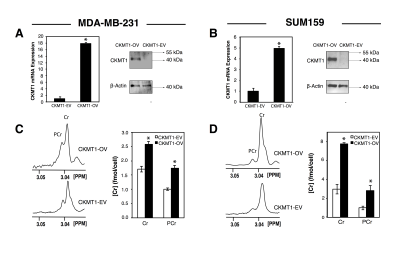 |
18 | Ubiquitous Mitochondrial Creatine Kinase (CKMT1) Drives Malignant Creatine Metabolite Profiles in Human Breast Cancer Cell Lines
Vinay Ayyappan, Caitlin Tressler, Menglin Cheng, Kanchan Sonkar, Ruoqing Cai, Michael McMahon, Kristine Glunde
Ubiquitous Mitochondrial Creatine Kinase (CKMT1) is a mitochondrial membrane protein that catalyzes the reversible conversion of creatine (Cr) to phosphocreatine (PCr). This study shows that in two triple-negative breast cancer cell lines, CKMT1-overexpression resulted in significant increases in intracellular Cr and PCr and conferred increases in cell viability while decreasing migration, invasion and adhesion. Since CKMT1 has been identified as a prognostic indicator in several cancers, it may play a role in oncogenesis and/or cancer progression. Thus, CKMT1 holds promise as a potential diagnostic marker and/or treatment target whose expression can be monitored using magnetic resonance spectroscopy-detected Cr and PCr levels.
|
4219. 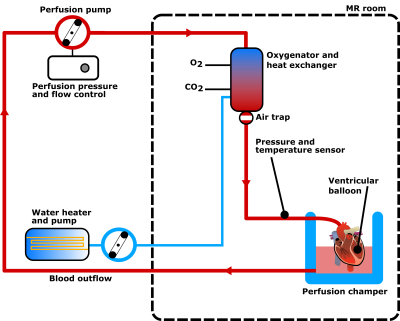 |
19 | Development of a human heart sized perfusion system for metabolic imaging studies using hyperpolarized [1-13C]pyruvate MRI
Christian Mariager, Esben Hansen, Sabrina Bech, Peter Nielsen, Steffen Ringgaard, Hans-Henrik Kimose, Christoffer Laustsen
In order to combat the increasing worldwide organ shortage, increased understanding of the role of deranged metabolism in the donor organ is vital. This is especially true in the case of the heart, where the ability to assess cardiac metabolism during storage pending transplantation, has the potential to utilize marginal organs and elevate the graft viability. Here we present the development of a MR compatible perfusion system used in combination with hyperpolarized [1-13C]pyruvate and conventional MRI. This enables detailed investigations into ex-vivo cardiac metabolism and function in a large animal model, resembling the case in humans.
|
|
4220. 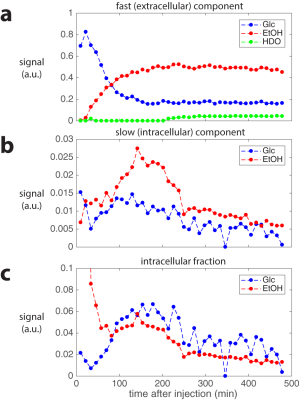 |
20 | Separation of Intracellular and Extracellular Metabolites during Glucose Fermentation using Diffusion-Weighted Deuterium (2H) Spectroscopy
Josephine Tan, Rachel Chan, Albert Chen, Angus Lau
In cancer, high extracellular lactate concentrations are associated with tumour aggressiveness, immune evasion and metastatic potential. We show that diffusion-weighted STEAM 2H-MRS of deuterium-enriched substrates can differentiate between intracellular and extracellular metabolites. Experiments in a model yeast system show the feasibility of detection of intracellular ethanol accumulation, produced via anaerobic fermentation of deuterium enriched glucose. These studies show potential to improve the capability of 2H-MRS for assessment of tumour aggressiveness.
|
|
4221  |
21 | Non-invasive intracranial detection of the small molecule inhibitor BAY 1436032 in an orthotopic glioma model using 19F MR spectroscopy Video Permission Withheld
Katharina Wenger, Michael Burger, Christian Richter, Joachim Steinbach, Harald Schwalbe, Stefan Kaulfuss, Elke Hattingen, Bähr Oliver, Ulrich Pilatus
BAY 1436032 is a small-molecule inhibitor of the R132X-mutant form of IDH1 with a trifluoromethoxy-group that is currently clinically investigated in IDH1-mutant solid tumors. Non-invasive monitoring of intracranial drug delivery of BAY 1436032 in an animal model using 19F MRS is technically challenging but feasible.
|
|
4222. 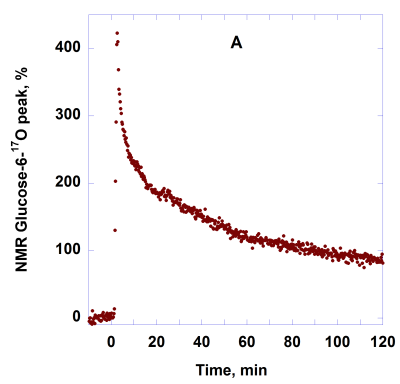 |
22 | Limitation of glucose consumption in rat head detected by labeled glucose-17O
Victor Schepkin, Shannon Helsper, Cathy Levenson
In animal experiments using 17O labeled glucose, questions arose regarding the relatively stable rate of glucose metabolism, compared with a simultaneous variation in glucose concentration after bolus injection. Bolus Glucose-6-17O administration with doses 3-15 μmol/g for normal rats revealed the same glucose consumption with CMRglc = 0.43 ± 0.06 μmol/g tissue/min. After bolus injection, the rate of glucose metabolism was consistent in each dose regardless of the large variation in glucose concentration. The results correlate with the observations of others, indicating that glucose-6-phosphate (G-6-P) does not accumulate in hyperglycemia and can limit glucose consumption.
|
|
4223 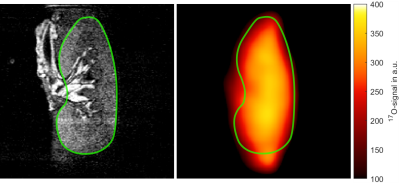 |
23 | Protocol Optimization for Functional 17O-MRI of Donor Kidneys at 3T Video Permission Withheld
Yanis Taege, Johannes Fischer, Ali Özen, Hao Song, Christian Schuch, Rianne Schutter, Cyril Moers, Ronald Borra, Michael Bock
Direct 17O-MRI is able to measure the dynamics of renal metabolism in a porcine kidney in an organ transplantation setup at 3T. To obtain stable SNRs above 20 over time while maintaining a spatial resolution below 8 mm, we investigated the influence of nominal spatial resolution, bandwidth and acquisition time window of a UTE-sequence with a golden-angle acquisition pattern on SNR. Signal increase of up to 25% per liter of 17O-gas was observed in a pilot experiment.
|
|
4224. 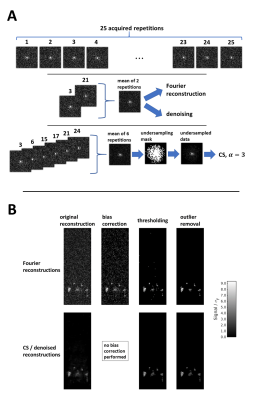 |
24 | Fluorine Nanoparticle Quanti?cation in a Mouse Model of Neuroin?ammation: Reference-Based Bias Correction for Conventional and Compressed Sensing Reconstructions
Ludger Starke, Andreas Pohlmann, Thoralf Niendorf, Sonia Waiczies
Fluorine-19 MRI has emerged as a promising tool for in vivo cell tracking, yet low achievable signal-to-noise ratios remain a major challenge. Compressed sensing offers increased sensitivity at the cost of introducing signal intensity bias. We show that at low signal levels the quantification performance of compressed sensing is similar to conventional methods due to signal intensity distribution induced bias effects, which also affect the Fourier reconstruction. To improve quantification results, we propose an intensity correction scheme based on ex vivo reference data.
|
|
4225. 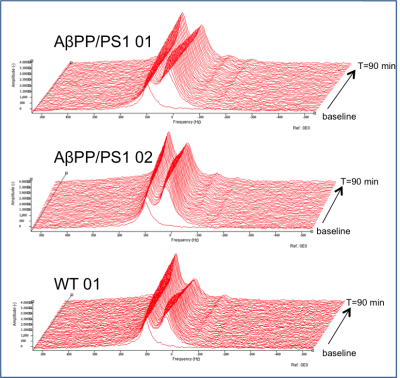 |
25 | Glucose metabolism in the brain of an Alzheimer mouse model by deuterium MRS
Andor Veltien, Jack Van Asten, Tom Peeters, Maximilian Wiesmann, Ria De Haas, Amanda Kiliaan, Arend Heerschap
In this study we show that Deuterium Magnetic Resonance Spectroscopy (DMRS) of the mouse brain after a bolus application of [6,6’-2H2]glucose is feasible at a high SNR and time resolution. We demonstrate that this can be applied to a transgenic mouse model of Alzheimer disease showing clear differences in the glucose uptake and metabolism with a WT mouse. In Deuterium Metabolic Imaging (DMI) mode this could be an alternative approach for FDG PET in Alzheimer disease.
|
MRS Acquisition & Analysis
Digital Poster
Digital Poster
Spectroscopy & Non-Proton MR
Wednesday, 15 May 2019
| Exhibition Hall | 16:45 - 17:45 |
| Computer # | |||
4226. 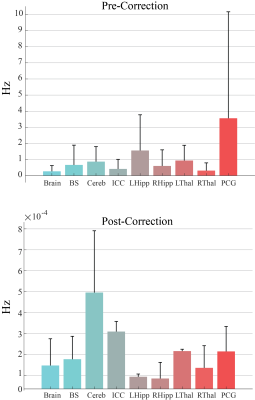 |
26 | The Effect of B0 Inhomogeneities on Shim Coil Mapping: A Problem and its Solution Presentation Not Submitted
Deena Roller, Assaf Tal
B0 field inhomogeneities lead to distortions in gradient echo acquired field maps. In particular, these distortions are present when mapping the spatial distribution of a system's shim coils. Here, we assess the effect of these distortions using in-vivo data and computer simulations, and suggest an iterative algorithm which completely removes them without the need of any additional acquisitions.
|
|
4227. 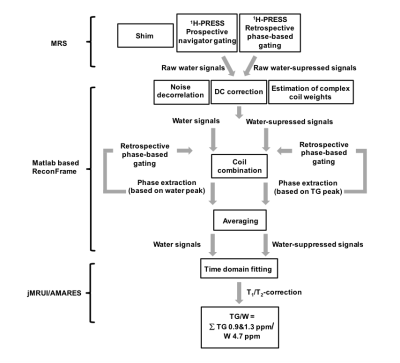 |
27 | Retrospective Phase-Based Gating for Cardiac Proton Spectroscopy with Fixed Scan Time
Mareike Gastl, Sophie Peereboom, Maximilian Fuetterer, Florian Boenner, Malte Kelm, Robert Manka, Sebastian Kozerke
Respiratory motion is a major limiting factor for the application of cardiac proton MR spectroscopy (MRS) in clinical settings. Prospective navigator gating is frequently applied to minimize respiratory motion effects. However, scan durations are subject-dependent and hence difficult to predict. The present work describes cardiac proton MRS with fixed scan time employing retrospective phase-based gating. It is demonstrated that, relative to prospective navigator gating, the phase-based gating approach provides comparable triglyceride-to-water ratios with predictable scan time.
|
|
4228. 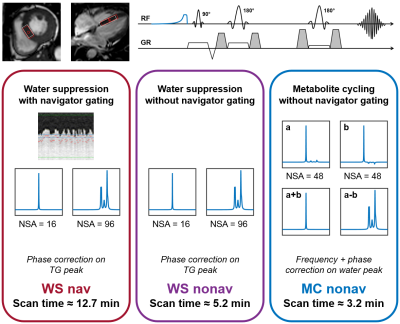 |
28 | Navigator-free Metabolite-Cycled Cardiac Proton Spectroscopy
Sophie Peereboom, Mareike Gastl, Maximilian Fuetterer, Sebastian Kozerke
Respiratory gating is a burden of conventional cardiac water-suppressed proton spectroscopy and averages are typically phase corrected based on the low-SNR triglyceride signal. Metabolite cycling allows to perform frequency and phase correction on the high-SNR water signal, which might alleviate the necessity for respiratory gating. In this work navigator-free metabolite-cycled cardiac proton spectroscopy was compared with navigator-free water-suppressed and navigator-gated water-suppressed measurements. Analyses based on relative Cramér-Rao lower bounds, creatine-to-water and triglyceride-to-water ratios were performed. Navigator-free metabolite-cycled scans were 3-4 times faster compared to conventional navigator-gated water-suppressed scans while improving signal quality.
|
|
4229. 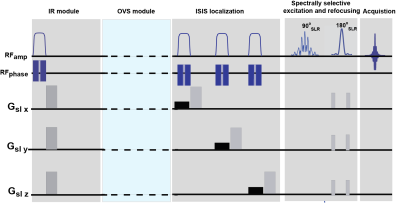 |
29 | Characterization of downfield spectra using iRE-MRS
Sonia Goncalves, Clémence Ligneul, Noam Shemesh
About half of the proton spectrum (downfield of water) has been nearly ignored over the decades of MRS application due to water suppression. We show that ISIS-based Relaxation Enhanced MRS (iRE-MRS) which uses frequency selective excitation and ISIS localization offers short echo times and enhances exchange-broadened resonances. We take advantage of this to characterize the relaxation properties of downfield spectral peaks.
|
|
4230. 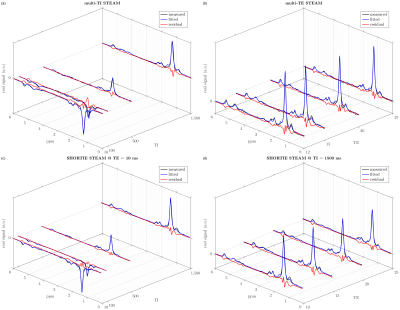 |
30 | Single-voxel short-TR multi-TI multi-TE (SHORTIE) STEAM for water–fat magnetic resonance spectroscopy
Stefan Ruschke, Dominik Weidlich, Mingming Wu, Andreas Hock, Dimitrios Karampinos
Single-voxel MR spectroscopy (MRS) serves as a reference method in fat containing tissues to probe T1, T2 and proton density fat fraction (PDFF). Currently, employed techniques usually rely on long TRs to minimize T1 bias albeit the prolonged scan time and the reduced SNR efficiency. The purpose of this study is to propose the usage of a short-TR multi-inversion time (TI) multi-TE (SHORTIE) STEAM for the simultaneous assessment of T1, T2 and PDFF at reduced scan times when compared to long-TR multi-TI STEAM and long-TR multi-TE STEAM. The agreement between the aforementioned methods was tested in the exemplary application of adipose tissue characterization in the human supraclavicular fossa.
|
|
4231. 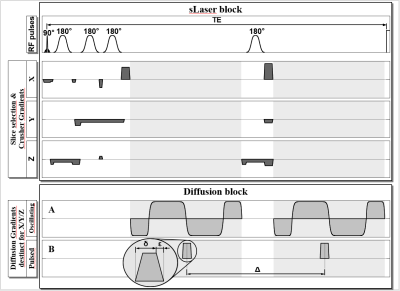 |
31 | Towards probing diffusion barriers for water and metabolites in skeletal muscle by MR spectroscopy using oscillating and pulsed diffusion gradients with a large range of diffusion times
Kadir Simsek, Andre Döring, Roland Kreis
Diffusion-weighted MR spectroscopy has recently been shown to help elucidate the microstructure of brain tissue and the use of oscillating gradients in MRI has provided the option to study local features on a smaller scale. Here, we aim at combining both techniques to investigate human skeletal muscle in vivo on a clinical scanner. Oscillating and pulsed gradient schemes with a large range of diffusion times were applied with otherwise identical acquisition settings. Initial results are shown, but also the challenges faced for muscle where physiologic pulsation and gradient-related artifacts may be prominent.
|
|
4232. 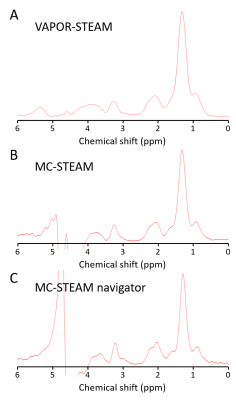 |
32 | Implementation of metabolite cycled liver 1H MRS on a 7T parallel transmit system
Ariane Fillmer, Catalina Arteaga de Castro, Aline Xavier, Peter Luijten, Dennis Klomp, Jeanine Prompers
Single-voxel 1H MRS in body applications often suffers from respiratory and other motion induced phase and frequency shifts, which lead to incoherent averaging and hence to suboptimal results. Here we show the application of metabolite cycling (MC) for liver 1H MRS on a 7T parallel transmit system, using 8 transmit-receive fractionated dipole antennas with 16 additional, integrated receive loops. The preserved water signal in MC-MRS allowed for robust phase and frequency correction of individual acquisitions before coil combination and averaging, which resulted in in-vivo liver spectra with an improved spectral resolution as compared with MRS with VAPOR water suppression.
|
|
4233. 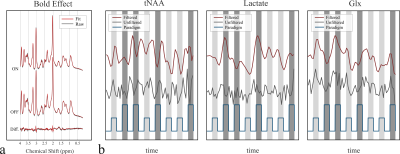 |
33 | Functional Magnetic Resonance Spectroscopy of the Sensory and Attentional Auditory Processing at 7T
Eduardo Coello, Nicolas Bolo, George Chiou, Huijun Liao, Molly Charney, Tyler Starr, Elisabetta Del Re, Margaret Niznikiewicz, Alexander Lin
This work describes a methodology to perform functional MR spectroscopy (
|
|
4234. 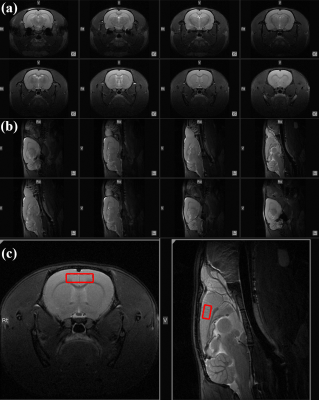 |
34 | An in vivo proton magnetic resonance spectroscopy study with multi-echo-time technique for concurrent quantification and T2 measurement of glutamate
Chi-Hyeon Yoo, Hyeon-Man Baek, Kyu-Ho Song, Dong-Cheol Woo, Bo-Young Choe
The purpose of the study was to propose a multiple-echo-time (TE) in vivo proton magnetic resonance spectroscopy (MRS) for a concurrent quantification and T2 measurement of glutamate. Point-resolved spectroscopy with eight TE values was used. The validity of selected TEs for T2 estimation of glutamate was verified by the spectral analysis. Comparison results showed that the reliability of the proposed method was comparable to that of typically used MRS techniques for quantification and T2 estimation, respectively. The proposed method can concurrently measure concentration and T2 of glutamate and effectively investigate brain metabolism and microenvironment in an acceptable scan time.
|
|
4235. 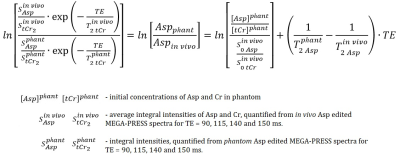 |
35 | T2 Measurement and quantification of cerebral white and gray matter aspartate concentrations in vivo
Petr Menshchikov, Andrei Manzhurtsev, Maxim Ublinskii , Tolib Akhadov, Natalia Semenova
In this study for the first time in vivo transverse relaxation rate (T2) of aspartate (Asp) from Asp edited MEGA-PRESS spectra using phanton data were quantified as 161±33 ms. Asp concentrations in gray matter (GM)- and white matter (WM)-dominant brain regions were measured as 2.78±0.21 mM vs 1.04±0.16 mM, respectively. Estimation of the absolute Asp concentrations with Asp editing MEGA-PRESS has potential in many research applications, such as studying the processes underlying the reduction of N-acetyl aspartate. The T2 measurement method which has been successfully applied for edited Asp signals can also be used for other strongly J-coupled signals.
|
|
4236. 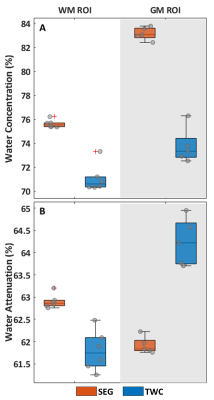 |
36 | Personalised Water Scaling: Quantifying absolute metabolite concentrations using measured tissue water content and attenuation maps
Carina Graf, Erin MacMillan, Laura Barlow, Irene Vavasour, Cornelia Laule
A quantitative total water content and relaxation method (TWC) was compared to the commonly used segmentation based approach (SEG) to calculate absolute metabolite concentrations in magnetic resonance spectroscopy. Significantly different water concentrations and attenuation factors were found between TWC and SEG in both grey and white matter from scans of 6 healthy controls at 3T. These differences led to significantly different concentrations of total creatine and myo-inositol in white matter, and N-acetyl-aspartate, total creatine, and glutamate in grey matter. The TWC approach is a promising alternative to improve MRS concentration estimates across healthy and diseased cohorts, and different MRI scanners.
|
|
4237. 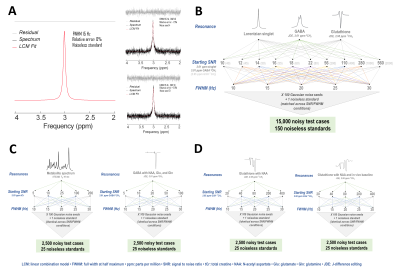 |
37 | Spectral quality differentially affects apparent concentrations of individual metabolites as estimated by linear combination modeling of in vivo MR spectroscopy data at 7 Tesla
Kelley Swanberg, Hetty Prinsen, Christoph Juchem
In vivo magnetic resonance spectroscopy currently lacks data-driven quality control standards, the development of which can be informed by characterizing the effects of spectral quality on metabolite quantification. We assess the influences of spectral line width and signal-to-noise ratio on both simulated and experimentally derived in vivo resonances from twenty-one metabolites measured by short-echo-time STEAM and J-difference editing for glutathione and GABA at 7 Tesla. We show that spectral quality exerts distinct effects on apparent concentrations of different metabolites, underlining the importance of explicit quality analysis in studies employing in vivo magnetic resonance spectroscopy, especially cross-sectional investigations of physiologically distinct groups.
|
|
4238. 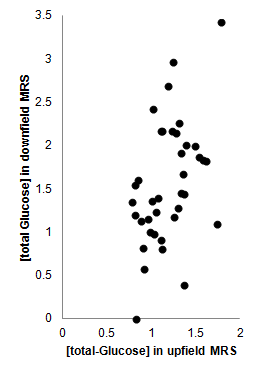 |
38 | Detection of metabolite concentration changes in young adult volunteer brains after oral glucose administration using short-TE STEAM 1H MRS sequence at 7T
Hideto Kuribayashi, Nouha Salibi, Ravi Seethamraju, Sinyeob Ahn, Koji Fujimoto, Tadashi Isa, Tomohisa Okada
Glucose detection was examined in young adult volunteer brains (the posterior cingulate cortex) with 1H downfield MRS at 7T, and metabolite concentration changes before and c.a. 55 minutes after oral 50-g glucose administration were measured with the downfield and a conventional upfield MRS. The downfield MRS detected H1-α-glucose peak at 5.3 ppm and quantified glucose concentration as a wider range compared to that with the upfield MRS using LCModel. Detection of the H1-α-glucose peak showed a potential to quantify net glucose concentration without underestimation.
|
|
 |
4239. 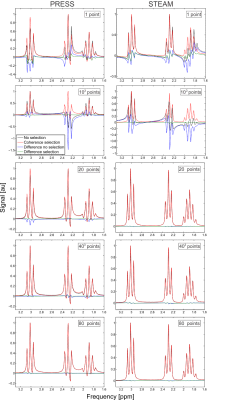 |
39 | Recommendations for Accurate Basis Set Generation for Magnetic Resonance Spectroscopy Quantification
Karl Landheer, Christoph Juchem
Data from magnetic resonance spectroscopy (MRS) experiments require quantification, which consists of fitting the measured data to a series of scaled, shifted and broadened spectral lines, referred to as a basis set. The numerical generation of basis sets necessitates certain assumptions and approximations to ensure practicality given the available computational power and memory size. However, these assumptions can substantially impact the derived spectral lineshapes. Common assumptions found throughout the literature were systematically investigated with our newly developed MAgnetic Resonance Spectrum Simulator (MARSS) software and recommendations are given to generate realistic basis sets for accurate quantification of MRS studies.
|
4240. 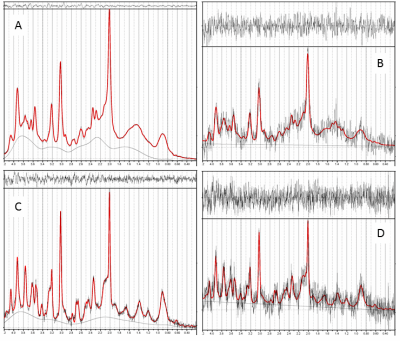 |
40 | Quantification issues of in vivo brain 1H NMR spectroscopy revisited
Jürgen Baudewig, Peter Dechent , Susann Boretius
Localized proton NMR spectroscopy is capable to measure in vivo brain metabolites in different diseases. Accuracy and precision of the quantification of metabolite concentrations is key, especially when comparing results from different patients, diseases, groups, sites or even species. Here we demonstrate that deterioration in SNR of the spectra does not only degrade the precision of obtained values but also could cause severe alterations of estimated absolute concentrations. E.g. aberrations of up to 100% or 8 mMol/L were found in Glx (Glutamate+Glutamine) concentrations.
|
|
4241. 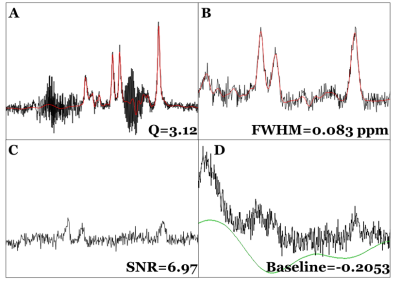 |
41 | No-Cost, Vendor-Agnostic MR Spectroscopy Fitting Software Can Predict Diagnostic Quality and Utility of Clinical Brain Studies
Samuel Einstein, Jason Johnson, R. Stafford
MR spectroscopy (MRS) allows for non-invasive assessment of tissue metabolites and is rapidly expanding in clinical use. Current MRS QC recommendations, however, are phantom-based and infrequent. This study investigated the feasibility of using no-cost, vendor-agnostic fitting software to provide quantitative quality assessment of patient brain MRS. We demonstrated that freely-available MRS fitting software can stratify spectral diagnostic quality and utility. This technique can be used to provide the clinician with an estimate of quality for each patient spectrum. Additionally, this approach is amenable to real-time patient MRS quality verification and longitudinal monitoring of protocol performance.
|
|
4242. 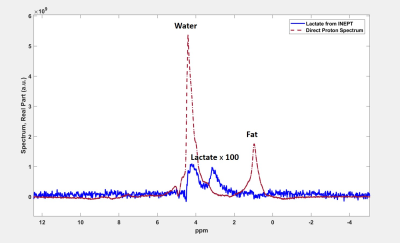 |
42 | A Time Series Analysis Method to Achieve Improved Water Suppression in 1H MRS
Keshav Datta, Daniel Spielman
Adequate suppression of water signal is vital in detecting low concentration metabolites in in-vivo proton spectroscopy acquisitions. This problem, which is exacerbated in the presence of multiplicative noise induced by physiological motion, is not addressed by current water and lipid saturation-based approaches. Here we use a time series modeling approach and show that signal estimation techniques are extremely effective in suppressing the highly correlated physiological noise component to achieve over three orders of magnitude in-vivo water suppression.
|
|
4243.  |
43 | Impact of wavelets and apodisation in magnetic resonance spectroscopy quality for paediatric brain tumours
Dadi Zhao, James Grist, Yu Sun, Andrew Peet
Ependymomas, medulloblastomas and pilocytic astrocytomas are common paediatric central nervous system tumours. In vivo 1H magnetic resonance spectroscopy is a non-invasive technique to determine tumour metabolic characteristics, however suffers from limited signal-to-noise ratios. Our previous studies demonstrated that metabolite concentration estimation may be improved through wavelet de-noising on both simulated and in vivo MRS data, as reflected by improved tumour classification. In this study we compared improvements in fit quality using both wavelets and apodisation on simulated and in vivo MRS data of the three tumours by measuring overall and regional SNR.
|
|
4244.  |
44 | Effects of outer volume saturation RF pulses and chemical shift displacement on MRS data
Diana Rotaru, Dimitra Tsivaka, David Lythgoe
We investigated the effect of outer volume saturation (OVS) using very selective saturation pulses (VSS) on metabolite concentrations in PRESS MRS. Our results show that if the PRESS excitation voxel isn’t increased in size, metabolite concentrations are overestimated compared with not using VSS-OVS. These results will be of interest to other researchers planning or conducting multi-centre MRS studies.
|
|
 |
4245. 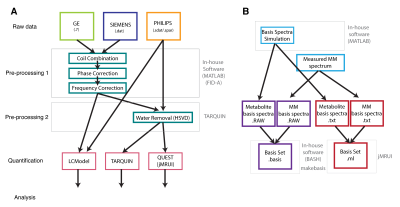 |
45 | The use of multi-vendor, multi-site 1H-MRS data acquired at 26 sites as a benchmark for MRS standardization: Comparison of quantification software
Michal Považan, Mark Mikkelsen, Adam Berrington, Peter Barker, Pallab Bhattacharyya, Maiken Brix, Pieter Buur, Kim Cecil, Kimberly Chan, David Chen, Alexander Craven, Koen Cuypers, Michael Dacko, Niall Duncan, Ulrike Dydak, David Edmondson, Gabriele Ende, Lars Ersland, Fei Gao, Ian Greenhouse, Ashley Harris, Naying He, Stefanie Heba, Nigel Hoggard, Tun-Wei Hsu, Jacobus Jansen, Alayar Kangarlu, Thomas Lange, R. Marc Lebel, Yan Li, Chien-Yuan Lin, Jy-Kang Liou, Jiing-Feng Lirng, Feng Liu, Joanna Long, Ruoyun Ma, Celine Maes, Marta Moreno-Ortega, Scott Murray, Sean Noah, Ralph Noeske, Michael Noseworthy, Georg Oeltzschner, Eric Porges, James Prisciandaro, Nicolaas Puts, Timothy Roberts, Markus Sack, Napapon Sailasuta, Muhammad Saleh, Michael-Paul Schallmo, Nicholas Simard, Diederick Stoffers, Stephan Swinnen, Martin Tegenthoff, Peter Truong, Guangbin Wang, Iain Wilkinson, Hans-Jörg Wittsack, Adam Woods, Hongmin Xu, Fuhua Yan, Chencheng Zhang, Vadim Zipunnikov, Helge Zöllner, Richard Edden
In vivo 1H-MRS is useful for studying neurological pathology, however its integration into clinical routine remains incomplete. Quantification of 1H-MRS data is affected by the analysis pipeline, but the source and extent of this bias is often unknown. Therefore, a large multi-vendor, multi-site dataset (n=296) was processed with an automated pipeline and three quantification software packages: LCModel, TARQUIN, and QUEST. Pearson’s correlation coefficient ranged from 0.66-0.88 for LCModel vs. TARQUIN and from 0.02-0.47 for QUEST vs. LCModel and QUEST vs. TARQUIN. A different baseline handling was the major potential source of variation between quantification software.
|
4246. 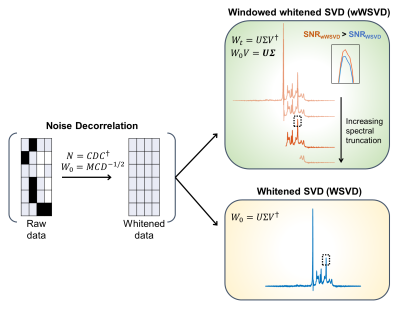 |
46 | Windowed whitened singular value decomposition (wWSVD): An improved data-driven strategy for combining MR spectra from multi-channel phased array coils
Ren Geryak, Kelsey Li, Maame Owusu-Ansah, Xiaodong Zhong, Hui Mao, Candace Fleischer
Data driven methods to combine multi-channel phased array data such as singular value decomposition (SVD) can greatly improve SNR in MR spectra. Current SVD implementation has two primary limitations: 1) the assumption that noise is independent between coil channels; and 2) utilization of the entire spectrum to calculate the optimized coil combination. Here, we present a method using a whitened SVD (WSVD) matrix to decorrelate noise from individual coil elements, followed by an optimized and iterative windowing approach termed windowed whitened SVD (wWSVD) to determine the optimal subset of the spectrum for SVD analysis that is then used to combine multi-channel spectral data. We report a significant in vivo improvement in spectral SNR using wWSVD over WSVD.
|
|
4247. 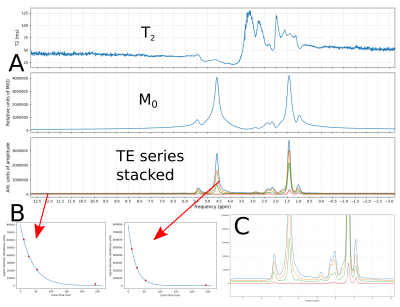 |
47 | Pointwise T2 fitting for spectral relaxography: examples in dystrophic and healthy muscle
Eric Baetscher, William Triplett, Glenn Walter, William Rooney
We present a model-free approach for frequency domain transverse relaxation time (T2) analysis and post-processing. Multiple echo-time (TE) magnetic resonance spectroscopy (MRS) data is fit for M0 and T2 at each point in the frequency spectrum to produce derived plots of T2 as a function of chemical shift. T2 values of certain in-vivo resonances are in good agreement with prior literature. The spectral T2 (sT2) obtained by pointwise fitting and plotting shows remarkably defined features. Results are shown for spectra obtained from normal leg muscle and muscle in subjects with Duchenne Muscular Dystrophy (DMD).
|
|
4248. 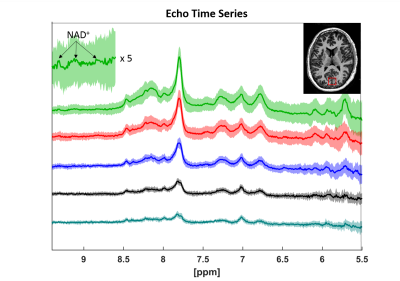 |
48 | Characterization of Downfield Resonances and their T2 Relaxation times in Human Brain at 9.4 T
Saipavitra Murali-Manohar, Tamas Borbath, Andrew Wright, Anke Henning
In this abstract, we report the apparent T2 relaxation times of the downfield peaks in the human brain at 9.4 T. In addition, we look for correlations between different downfield peaks and between downfield and upfield metabolites. Further, concentrations of all downfield resonances after correcting for both water and peak relaxation times are reported for the first time.
|
|
4249. 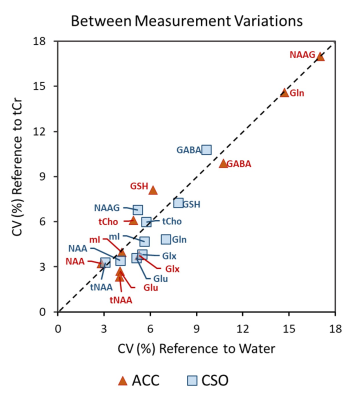 |
49 | Comparison of 7T MRS Reproducibility Using either Creatine or Water Referencing in Patients with Schizophrenia
Anna Wang, Laura Rowland, Andrea Wijtenburg, Peter Barker
This study investigated the reproducibility of 7T MRS of gray and white matter in ten patients with schizophrenia (SZ), using either water or total creatine (tCr) as internal references. All ‘high concentration’ metabolites such as NAA, glutamate, choline and others, and some low concentration metabolites, such as glutamine and NAAG were reliably determined. Referencing to either water or tCr gave similar reproducibility.
|
|
4250. 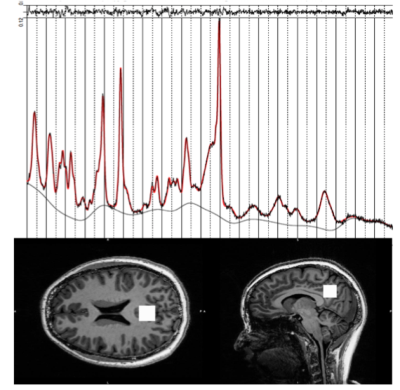 |
50 | Ultra-high field MRS and high spatiotemporal resting fMRI of the default mode network: A reproducibility study
Bradford Moffat, Ofer Gonen, Rebecca Glarin, Patrick Kwan, Patricia Desmond, Elaine Lui, Terry O'Brien
This study investigated the reproducibility of measuring brain glutamatergic nuerotransmitters and glutathione using MRS, and their correlation with high spatiotemporal resolution resting state fMRI and subject age at 7T. Repeat MRS measurements across two time points showed excellent reproducibility (ICC > 0.75) for all metabolites. Both the ratio of Glutamate/Gaba and functional connectivity correlated independently with subject age. Ultra-high field MR is ideal for studying the association between brain biochemistry and function in neurological diseases.
|
(B) MRS: Acquisition & Analysis 2
Digital Poster
Digital Poster
Spectroscopy & Non-Proton MR
Wednesday, 15 May 2019
| Exhibition Hall | 16:45 - 17:45 |
| Computer # | |||
4251.  |
72 | Proton MRS and resting state fMRI study of hyperbaric oxygenation effects at 3 Tesla Presentation Not Submitted
Andrei Manzhurtsev, Natalia Semenova, Natalia Zaytseva, Viktoria Sergeeva, Petr Menshchikov, Maxim Ublinskiy, Tolib Akhadov
Previously we demonstrated that one hyperbaric oxygenation (HBO) session causes the energy metabolism activation in order to compensate the expenses on NAD(H) synthesis. This study is aimed to reveal the effects of HBO on the 1H MRS brain metabolites and the correlated activity in DMN at 3 Tesla. The results demonstrate that even one low-pressure HBO session in healthy subjects stimulates NAA brain metabolism and increases the MPFC-PCC functional connectivity. Further research of HBO effects on neuronal pathology subjects is of interest.
|
|
4252 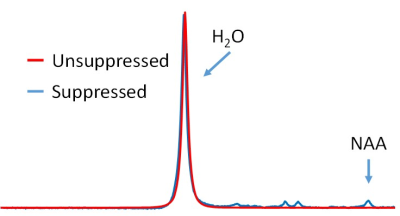 |
73 | Error estimate in temperature measurement using 1H MRS with water suppression Video Permission Withheld
Zhengchao Dong, Mate Milak, J Mann
Proton MRS thermometry exploits the property of temperature dependence of water signal. Most of MRS thermometry utilizes partially suppressed water signal or separately measured water signal without water suppression, in addition to the water suppressed signal for metabolites. This work shows that these approaches are either inaccurate or imprecise. The resultant errors may undermine clinically significant temperature changes. Simultaneous or interleaved measurement of unsuppressed water signal and metabolite/lipid signal is desirable.
|
|
4253. 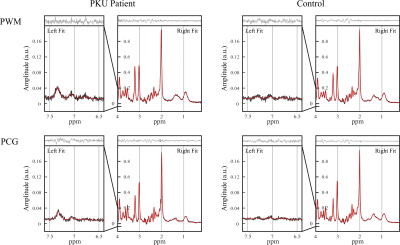 |
74 | Regional Differences in Cerebral Phenylalanine Measured with Single Voxel Spectroscopy using PRESS localization and LCModel Quantification Presentation Not Submitted
Eduardo Coello, Huijun Liao, Cassandra Papaleo, Molly Charney, Tyler Starr, Sai Merugumala, Susan Waisbren, Alexander Lin
This work describes a methodology for the quantification of phenylalanine in the brain, using standard single voxel spectroscopy with PRESS localization and LCModel quantification. The signals downfield from the water peak were modeled incorporating metabolite basis functions to the standard LCModel basis set. Phantom calibrations tailored for the acquisition protocol were performed to obtain corrected concentration ratios that showed significant regional differences (p<0.001) and high intrasubject correlation (R=0.73).
|
|
4254. 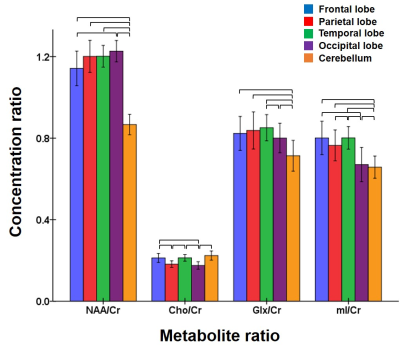 |
75 | Distribution of Major Brain Metabolite Ratios in Adults: The Observations of Whole Brain Magnetic Resonance Spectroscopic Imaging Study Presentation Not Submitted
Xinnan Li, Khin Tha, Kagari Abiko, Sinyeob Ahn, Yuta Urushibata, Kohsuke Kudo, Hiroki Shirato
We evaluated the normative major metabolite ratios of adults by using whole-brain magnetic resonance spectroscopic imaging (MRSI). The major metabolite ratios of the brain vary with region, age
|
 Back to Program-at-a-Glance |
Back to Program-at-a-Glance |  Back to Top
Back to Top